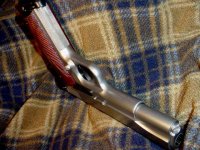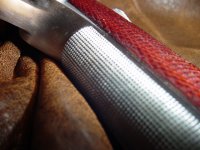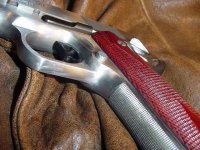Dave Sample
Moderator
A Gypsy Curse? Or a Fun Hobby? Old Fashioned way to do it? I have been checkering metal long enough to have a dread of those files that is almost impossible to overcome these days. I have two to do and I am really stopped dead in the Water! I can remember the good old days when I would put the band aids on every finger, chuck u the lower end in the good old vice with the brassd jaws, and make that first few cuts at the top of the front strap and "Get R Done" I would checker everything in sight that needed it and then do some fun stuff that helped function, but was not important to most people. Here is how it looks on the gun.

Look at the bottom surface of the slide stop. 30 LPI checkering to make it sticky.

Make sure the inside is smoooooth!

Here is the top view of the stops I like to play with.

Galmp it in the vice and do the long lines first.

Look at the bottom surface of the slide stop. 30 LPI checkering to make it sticky.

Make sure the inside is smoooooth!

Here is the top view of the stops I like to play with.

Galmp it in the vice and do the long lines first.









